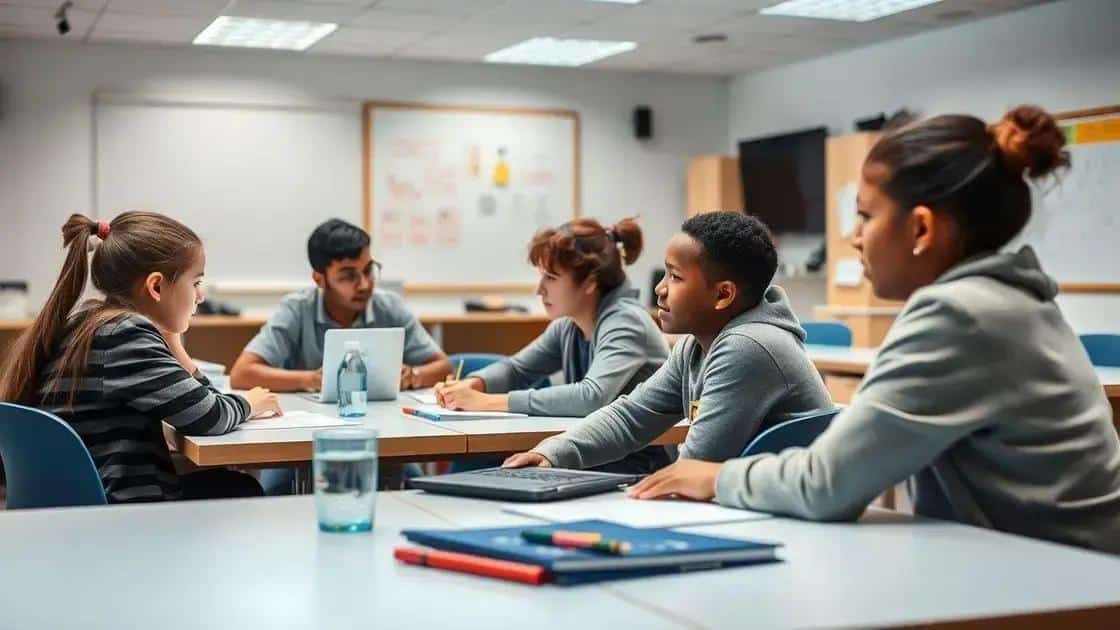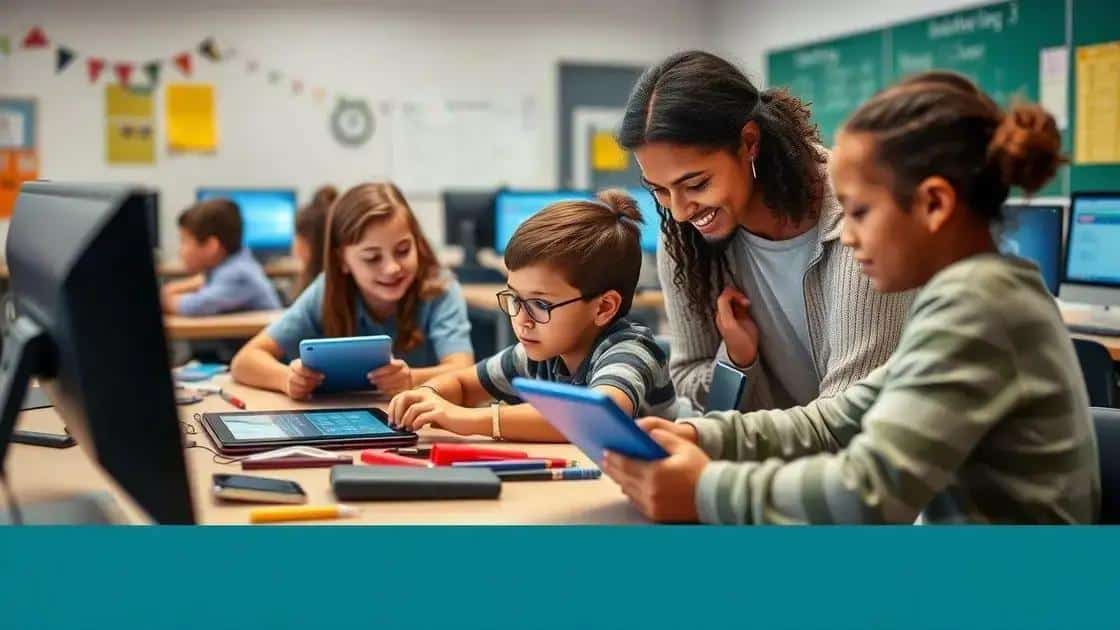Wish curriculum improvement ideas that can transform education

Measuring the success of curriculum changes involves setting clear learning outcomes, utilizing diverse assessment tools, collecting student feedback, and analyzing data to ensure educational improvements effectively meet student needs.
Are you curious about how wish curriculum improvement ideas can revolutionize education? Many educators are seeking effective solutions to enhance student learning and engagement. This article explores practical strategies that can make a significant difference.
Understanding the current curriculum challenges
Understanding the current curriculum challenges is essential for effective education. Many schools face issues that hinder student learning and engagement. By identifying these challenges, educators can develop stronger curricula that meet the needs of their students.
One major challenge is the lack of relevance in content. Students often question why they need to learn certain subjects, which can lead to disinterest. Making connections between curriculum topics and real-world applications can increase student motivation.
Examples of Curriculum Challenges
Another significant issue is the disparity in resources. Schools in different areas often have unequal access to tools and materials, impacting the quality of education. Teachers may struggle to provide quality lessons without necessary support. It’s important to recognize these inequities and work towards a more balanced educational framework.
- Insufficient teacher training on new curriculum standards
- Limited access to technology for students
- Insufficient time for collaborative planning among educators
- Pressure from standardized testing affecting curriculum choices
Furthermore, adapting to the diverse needs of students can be challenging. With varying learning styles and paces, a one-size-fits-all approach is often ineffective. Tailoring instruction is crucial for engaging all learners.
Addressing Curriculum Gap
Identifying gaps in the curriculum is vital. Regular evaluations and updates can help in creating an effective and inclusive framework. Collaborating with teachers, administrators, and students can foster a curriculum that is dynamic and responsive. Encouraging feedback from the community can also enhance relevancy and effectiveness.
By addressing these challenges, educators can create a curriculum that not only meets academic standards but also resonates with students. This process requires ongoing reflection and willingness to change. Continuous improvement is key to fostering a successful learning environment.
Creative methods for curriculum enhancement
Creative methods for curriculum enhancement are essential in today’s ever-evolving educational landscape. With the rise of technology and diverse student needs, employing innovative approaches can make learning more engaging and effective.
One effective method is incorporating project-based learning into the curriculum. This approach allows students to work on real-world projects that foster critical thinking and problem-solving skills. By applying their knowledge, students can see the relevance of what they learn, which often boosts their motivation to succeed.
Integrating Technology
Integrating technology can also enhance the curriculum. Using tools like interactive software and online resources allows students to access information more efficiently. Gamification is another powerful method. Introducing game-like elements into lessons can transform the learning experience. It encourages more active participation, making tough subjects seem more approachable.
- Use virtual reality to create immersive learning experiences.
- Encourage collaboration through online platforms.
- Implement digital storytelling to develop creativity.
- Utilize educational apps for personalized learning.
Moreover, cross-disciplinary teaching can reap great benefits. Connecting subjects like math and science with arts can spark creativity and holistic understanding among students. For example, a project that involves both math concepts and artistic expression can deepen students’ knowledge and appreciation for both subjects.
Fostering a Flexible Learning Environment
Fostering a flexible learning environment is crucial. Allowing students to have a say in what they learn can lead to a more invested approach. When students feel their interests are considered, they are more likely to engage deeply with the material. Additionally, the incorporation of mindfulness and well-being activities can improve focus and productivity in the classroom.
Creating opportunities for student feedback is vital for continuously enhancing the curriculum. By incorporating student suggestions, educators can ensure that the lessons are relevant and effectively meet their learning needs. This collaborative approach makes the learning process more dynamic and responsive.
The role of technology in curriculum improvement

The role of technology in curriculum improvement is becoming increasingly important. With digital tools becoming widespread, educators can leverage technology to enhance learning experiences and outcomes.
One key aspect is the availability of online resources. Teachers can now access a wealth of information that can enrich their lessons. This includes videos, articles, and interactive materials that engage students in unique ways. The internet opens up possibilities that traditional textbooks cannot match. With digital platforms, students can explore subjects deeply, making education more vibrant and dynamic.
Blended Learning Models
Incorporating technology allows for the integration of blended learning models. Combining face-to-face classroom instruction with online learning provides flexibility for students to learn at their own pace. This approach accommodates different learning styles, ensuring that each student can thrive. For instance, educators can assign lessons online while providing in-person support when needed.
- Utilizing educational software for personalized learning plans.
- Incorporating interactive simulations to enhance understanding.
- Employing virtual classrooms to connect with remote learners.
- Leveraging analytics to track student progress and tailor instruction.
Moreover, technology fosters collaboration among students. Tools such as discussion boards and educational apps encourage interaction and teamwork. By working together on projects using shared digital platforms, students develop critical skills that are applicable in the real world. This collaborative learning makes lessons more engaging and relatable.
Enhancing Teacher Development
Integrating technology also benefits teachers by providing them with tools for professional development. Online courses and webinars allow educators to stay updated with the latest trends in education. By enhancing their skills, teachers can implement new strategies effectively in their classrooms. This continuous learning process not only improves teaching practices but also helps to foster a culture of innovation in schools.
It’s essential to remember that technology should complement, not replace, traditional teaching methods. The best outcomes occur when educators use technology wisely, merging it with proven teaching strategies. Thus, understanding the role of technology in curriculum improvement is vital for creating a modern educational environment that prepares students for the future.
Engaging students through innovative approaches
Engaging students through innovative approaches is crucial for effective learning. Traditional teaching methods often fail to capture students’ interest. By using fresh strategies, educators can create a more dynamic classroom environment that encourages participation.
One innovative approach is the use of hands-on learning. Students learn best when they can actively participate in the learning process. Activities like experiments, projects, and role-playing allow students to explore concepts in a tangible way. This method not only increases engagement but also helps deepen understanding and retention of material.
Incorporating Creative Arts
Integrating the arts into lessons is another way to engage students. By exploring subjects through music, dance, or visual arts, students connect with content on a more personal level. For example, a history lesson can be enriched by having students create a timeline mural or perform a historical play.
- Using storytelling to make lessons relatable.
- Encouraging creative writing as a means of expression.
- Introducing music and rhythm to facilitate learning.
- Using visual arts to illustrate concepts.
Moreover, incorporating technology enhances engagement as well. Using digital tools such as educational apps and interactive platforms can make learning more exciting. For instance, utilizing online quizzes and gamified learning can motivate students to participate actively. They can receive immediate feedback, making learning more interactive and enjoyable.
Promoting Collaborative Learning
Another effective approach is promoting collaborative learning. When students work together on projects, they not only share ideas but also develop teamwork skills. Group activities create a sense of community, making students feel more connected and willing to contribute. Teachers can facilitate this by designing assignments that require collaboration.
Additionally, real-world connections are vital for engagement. Incorporating community projects and field trips can help students relate their studies to the outside world. When students see the relevance of their education, they are more likely to stay motivated and invested in their learning journey.
Measuring the success of curriculum changes
Measuring the success of curriculum changes is vital to ensure that educational improvements are effective. Without clear evaluation metrics, it is challenging to determine whether the new curriculum meets students’ needs and enhances their learning.
One effective method is to set clear learning outcomes at the beginning of the curriculum design process. These outcomes should specify what students are expected to know and be able to do by the end of a course. By aligning assessments with these outcomes, educators can measure student progress effectively.
Utilizing Assessment Tools
Incorporating various assessment tools is essential for evaluating curriculum effectiveness. Both formative and summative assessments provide valuable insights into student learning. Formative assessments, like quizzes and projects during instruction, allow teachers to monitor progress and adjust teaching strategies as needed.
- Standardized tests to gauge overall knowledge levels.
- Performance assessments to demonstrate practical application of skills.
- Student portfolios to showcase work over time.
- Teacher observations to assess engagement and participation.
Furthermore, gathering feedback from students is invaluable. Surveys and focus groups can reveal student perceptions of the curriculum. Understanding why certain aspects resonate with students can help educators refine and improve curriculum design.
Analyzing Data for Insights
Data analysis is a powerful tool in measuring success. By examining trends in student performance and engagement levels before and after curriculum changes, educators can identify areas of strength and areas needing improvement. Comparing results across different cohorts can provide additional context to the data, deepening insights.
Ultimately, measuring the success of curriculum changes involves a comprehensive approach. Continuous improvement is the goal, necessitating regular reflection and adaptation. By analyzing data, incorporating feedback, and observing classroom dynamics, schools can make informed decisions that enhance educational outcomes.
Measuring the success of curriculum changes is crucial for creating an effective learning environment. By setting clear goals and employing various assessment tools, educators can track student progress and understand the impact of their teaching methods. Feedback from students plays a vital role in refining the curriculum, ensuring that it remains relevant and engaging. Additionally, analyzing performance data helps identify trends and areas for improvement. Continuous evaluation and adaptation are key to fostering a dynamic and successful educational experience.
FAQ – Frequently Asked Questions about Measuring Curriculum Success
Why is measuring curriculum success important?
Measuring curriculum success ensures that educational improvements are effective and aligned with student learning needs.
What are effective methods for assessing curriculum changes?
Effective methods include setting clear learning outcomes, using diverse assessment tools, and collecting student feedback.
How can data analysis help in measuring curriculum success?
Data analysis can reveal trends in student performance, helping educators identify strengths and areas needing improvement.
What role does student feedback play in curriculum evaluation?
Student feedback provides insights into their experiences, helping educators refine the curriculum to keep it relevant and engaging.






